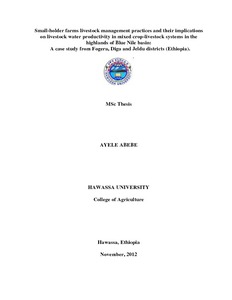Resource information
The study pertains to livestock management practices & their implications on Livestock Water Productivity (LWP) in the rain-fed crop-livestock systems in the Blue Nile Basin (BNB). Seven farming systems (Rice- Pulse & Teff-Millet from Fogera), (Barley-Potato, Teff-Wheat & Sorghum farming systems from Jeldu) & (Teff-Millet & Sorghum farming systems from Diga districts) were selected & a total of 220 sample Household (HH) heads were involved. Cattle were the major livestock species accounting for 83% of the total Tropical Livestock Unit. The preference of livestock species was in the order of Oxen, cows, sheep, goats & equines. Invariably across the study areas oxen were reared for the purpose of traction, income source & manure. The main purpose of keeping cows, sheep/ goats & equine were replacement, income sources and transportation, respectively. The main objective of integrating livestock into crop is mainly traction services. Farmers’ production objective is not market oriented & they are more focused on assisting crop production. Farmers in most farming systems keep cattle in the traditional Kraal system (enclosure without roofing). This affects animals’ physiology in extreme weather conditions thereby lowers LWP. Relatively better (68-83%) housing system (housing with roofing) was exercised in Barley-Potato & Teff-Wheat systems of Jeldu. Most HHs (57-100%) depended on river water sources for livestock drinking. Distance & quality of water were among the major problems raised by farmers. Most (97.3%) sample farmers practice natural mating for their livestock. They also select breeding animals based on their memory instead of performance recording. Much emphasis was put on physical appearance & color, respectively. Culling performed by farmers was very incomplete for it was not accompanied with performance recording. Breeding females were maintained in the herd for older age until reproductive performance nearly ceased. Lower milk yield & shorter lactation lengths, higher age at mating & calving, longer parturition intervals for female animals & higher age at first effective mating for breeding purposes by the bulls, jack & stallion were observed. Variability in performance within species observed between & among farming systems in this study are major indicators of potential to improve productivity & thereby LWP. Major livestock production constraints in the study farming systems were feed shortage, disease occurrence & shortage of initial capital. Higher mortality & low off-take rates for different livestock species were observed. Most important reasons for mortality rates were: disease, bloat & feed shortage. The mere management intervention in the time of harvesting & feeding of the local clovers & sorghum tillers could enable reduce mortality of cattle up to 40% at Jeldu. Average distance to get veterinary services was 9.6 km. Only 21 & 9% HHs get access to improved seeds & credit for livestock improvement, respectively. Mortality & morbidity affects LWP in two major ways: it reduces the efficiencies of the services & productivity of livestock. Secondly when animal dies water invested to feed the animal will be lost. This is important in view of the increasingly scarce agricultural water. Values of LWP across the study systems were lower & the differences among systems were not as such apparent. Lower LWP values were registered for relatively poor HHs (0.08 USD m-3) at Sorghum Diga & Barley-Potato farming systems of Jeldu districts. Highest (0.24 USD m-3) LWP value at HH level was registered for better-off farm clusters. More interesting is a huge gap between the minimum (0.001) & maximum values (0.627 USDm-3) of LWP. In view of this it can be concluded that there is huge potential to improve LWP in mixed crop livestock systems of the BNB. Although understanding the determinants of these variability are important future research policy options that increase farmers access to key livelihood resources is important. Future crop livestock integration must consider not only a short term economic return but long term environmental sustainability. Improving the production potential of local breeds through the different livestock management practices & reducing feed scarcity through food-feed integration adjoined with improved livestock & feed management, better veterinary access & improved extension service could be possible suggestions to lift up the current low livestock productivity and LWP.



